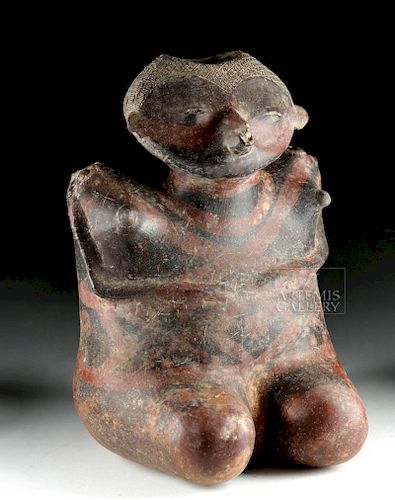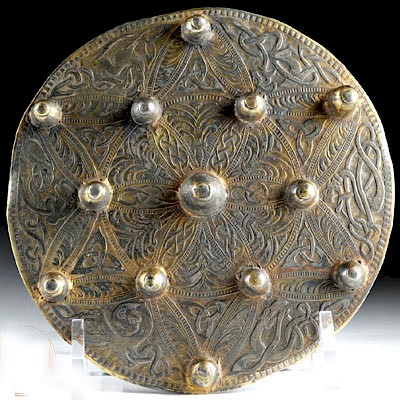Nayarit Chinesca Type B Tattooed Female Vessel
Lot 94
About Seller
Artemis Fine Arts
686 S Taylor Ave, Ste 106
Louisville, CO 80027
United States
Selling antiquities, ancient and ethnographic art online since 1993, Artemis Gallery specializes in Classical Antiquities (Egyptian, Greek, Roman, Near Eastern), Asian, Pre-Columbian, African / Tribal / Oceanographic art. Our extensive inventory includes pottery, stone, metal, wood, glass and textil...Read more
Estimate:
$8,000 - $12,000
Absentee vs Live bid
Two ways to bid:
- Leave a max absentee bid and the platform will bid on your behalf up to your maximum bid during the live auction.
- Bid live during the auction and your bids will be submitted real-time to the auctioneer.
Bid Increments
| Price | Bid Increment |
|---|---|
| $0 | $25 |
| $300 | $50 |
| $1,000 | $100 |
| $2,000 | $250 |
| $5,000 | $500 |
| $10,000 | $1,000 |
| $20,000 | $2,500 |
| $50,000 | $5,000 |
| $100,000 | $10,000 |
| $200,000 | $20,000 |
About Auction
By Artemis Fine Arts
Jul 19, 2018
Set Reminder
2018-07-19 10:00:00
2018-07-19 10:00:00
America/New_York
Bidsquare
Bidsquare : Fine Antiquities/Ethnographic Art
https://www.bidsquare.com/auctions/artemis-gallery/fine-antiquities-ethnographic-art-3329
Featuring classical antiquities, ancient and ethnographic art from cultures encompassing the globe, plus fine art. Artemis Fine Arts info@artemisgallery.com
Featuring classical antiquities, ancient and ethnographic art from cultures encompassing the globe, plus fine art. Artemis Fine Arts info@artemisgallery.com
- Lot Description
Pre-Columbian, West Mexico, Nayarit, ca. 300 BCE to 300 CE. A large and lovely hollow-cast female Chinesca figure with a characteristically-enlarged head, heart-shaped face, thick neck with a faint yellow-painted necklace, and hunched shoulders adorned with several circular discs. Seated upon seemingly-amputated, nubbin-shaped legs, this figure boasts a meditative pose with her voluptuous hips, arched back, and slight distended abdomen, with both arms held tightly against her sides below a pair of perky breasts. Noteworthy to this figure are the dense, dark-colored tattoos, with designs ranging from simple solid bands to intricate spotted and geometric motifs, all in a bichrome slip schema of burgundy and maroon. The tattooed designs envelop the majority of the figure's body and head, with the exception of her crosshatched coiffure. A truly remarkable example replete with earthtone imagery and classic Chinesca charm! Size: 6" W x 9" H (15.2 cm x 22.9 cm).
West Mexican shaft tomb figures like this one derive their names from the central architectural feature that we know of from this culture. These people would build generally rectangular vertical shafts down from the ground level down to narrow horizontal tunnels that led to one or more vaulted or rounded burial chambers. The geomorphology in the area means that these chambers are dug out of tepetate, a type of volcanic tuff material, which give the chambers a rough-edged look.
Although the dimensions of the chambers vary considerably - some only large enough to hold a single burial and its offerings, others seem designed to hold entire lineages - the placement of burial goods like this hollow figure was very similar. Grouped with other hollow figures, and alongside clay bowls, and boxes, they were positioned around the body (or bodies), near the skull. Unfortunately, we lack the information we would need to understand what these figures were made for - do they represent everyday people, even individuals? Are they religious? Were they created to mediate between the living and the dead? Whatever their purpose, today they are beautiful artwork and reminders of the mysterious past.
Provenance: private Pacific Palisades, California, USA collection; ex-Sidney Newman collection, Pre-1983, acquired in 1950's - 1970's
All items legal to buy/sell under U.S. Statute covering cultural patrimony Code 2600, CHAPTER 14, and are guaranteed to be as described or your money back.
A Certificate of Authenticity will accompany all winning bids.
We ship worldwide and handle all shipping in-house for your convenience.
#131036Expected surface wear commensurate with age, small chips to base, shoulders, and one ear, light roughness to base, with fading and minor loss to pigmentation, otherwise intact and excellent. Great craquelure to surface pigmentation. Nice earthen deposits, mineral deposits, and root marks throughout.Condition
- Shipping Info
-
All shipping is handled in-house for your convenience. Your invoice from Artemis Gallery will include shipping calculation instructions. If in doubt, please inquire BEFORE bidding for estimated shipping costs for individual items.
-
- Buyer's Premium



 EUR
EUR CAD
CAD AUD
AUD GBP
GBP MXN
MXN HKD
HKD CNY
CNY MYR
MYR SEK
SEK SGD
SGD CHF
CHF THB
THB

















